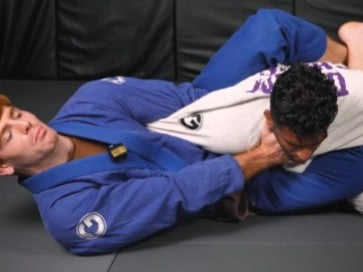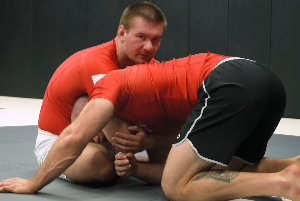If you’ve recently started training Brazilian jiu jitsu (BJJ), you might be wondering what it takes to progress to the next level. Working your way through the five colored belts (white, blue, purple, brown, and black) takes most practitioners a minimum of ten years, which just goes to show how mentally and physically challenging this martial art truly is.

Blue belt is the second rank and represents a significant achievement in jiu jitsu. Although it’s difficult to come up with hard numbers on how many white belts quit before reaching this milestone, estimates range anywhere from 50 to 90 percent! Anecdotally, if you take a look around your gym, you’ll probably come up with similar numbers of white belts who eventually just disappear.
The good news is, once you get to blue belt, you’ll likely start to feel much more comfortable with your skills and should be able to hold your own on the mats, which is a great incentive to keep pushing forward.
So what does it take to be a BJJ blue belt? Below, we’ll go over some of the basics to help you navigate your way to this important next step in your jiu jitsu journey.
How Long Does it Take to Earn a Blue Belt?

The short answer is, “It depends.” Most BJJ students will spend between one and two years at white belt. However, professors and coaches do take other things into consideration when deciding when it’s time to promote you:
Coaches understand that it’s unrealistic to compare every student strictly based on skill, since a 20-year old former wrestler who wants to be a world champion will have a much different approach than a 43-year old computer programmer who works full-time and is training just for the joy of the sport.
What Skills Should a Blue Belt Have?
Although some BJJ schools have tests for belts, many do not. Because evaluating someone’s skill in jiu jitsu can be fairly subjective (i.e., age, natural athleticism, previous experience, injuries, weight, gender, etc. all make a difference), most coaches don’t really have set requirements. However, there are some general rules of thumb.
Basic Hygiene and Uniform Care
Recognize the importance of keeping your nails neatly trimmed as well as basic hygiene rules to help keep you and your teammates free of athlete’s foot, ringworm, etc. Don’t be the stinky gi guy. Know how to tie your belt.
Understand Foundational Positions
White belt is all about establishing a basic understanding of the foundational positions of jiu jitsu: guard, side control, mount, knee on belly, back control, and turtle. Before you get your blue belt, you should be comfortable in all of these positions and know at least one escape from each.
Perform Basic BJJ Movements
Mastery of certain, basic BJJ movements is required to keep you safe or execute techniques correctly. You should be able to successfully perform a break fall, a bridge, a technical stand up, and a hip escape.

Use of Sweeps and Submissions
Implement Takedowns, Pulling Guard, Guard Retention and Passes
Even if you’re a guard puller, you should have at least one takedown in your back pocket. A blue belt should also be proficient at pulling guard and retaining guard. At a minimum, you should also know at least two ways to break and pass guard.
Should a Blue Belt Be Able to Smash Every White Belt?
Given how subjective jiu jitsu can be, it’s unreasonable to think that a blue belt should necessarily be able to dominate any white belt they encounter. However, someone at a blue belt level of proficiency should certainly be able to defend themselves effectively against someone with equal or less experience.
Can Blue Belts Defend Themselves Against Someone Who Doesn’t Train Jiu Jitsu?
Jiu jitsu has its roots in self-defense. By the time you’ve reached the blue belt level, you will have a much better understanding of how to control distance and position in such a way that you should definitely have the advantage against someone who doesn’t train jiu jitsu.
Do I Need to Compete to Earn My Blue Belt?
At most schools, no. If your gym requires you to compete to earn your next belt, they will probably make that clear from the beginning. Even if your school does not require you to compete, there are definitely some things that are best learned in a competition setting where you and your opponent are going 100 percent. The stress of a competition is difficult to replicate in regular sparring sessions, and competing can help you identify parts of your game where you need more work.
What Should I Do if I’m Not Getting Promoted?
If you are a white belt who has been toiling away for years and feel like you have a good grasp on what it takes to be a blue belt but are still not getting promoted, what should you do? First of all, don’t ask for a promotion. Most professors and coaches will take this as a sign that you are training jiu jitsu for the wrong reasons and are focused on the belt, not the journey.
Instead, approach your coaches and ask for suggestions on what you can do to improve your game. Invest in some private lessons. Increase your attendance. Get a notebook to write out the techniques you go over in class, so you can study them again on your own time. Watch instructional videos. Get a training dummy and drill at home.
It might take a little bit of humility to put in more work even when you feel like you’ve already done enough, but when you start seeing your BJJ skills improve, it’s worth it. Because, in the end, isn’t that why we’re all training anyway?
On the other hand, if you truly have worked as hard as you can, and you’re even doing extra work off the mats, and your coaches are not recognizing you, you might consider whether the culture of that particular gym is the right fit for you. It might be worth checking out other gyms in your area to see if that’s the case.
Just remember, jiu jitsu is a marathon, not a sprint. Be patient with the process and with yourself. The journey is worth it.
If you want to hear more about what it takes to be a blue belt, check out this short video:



